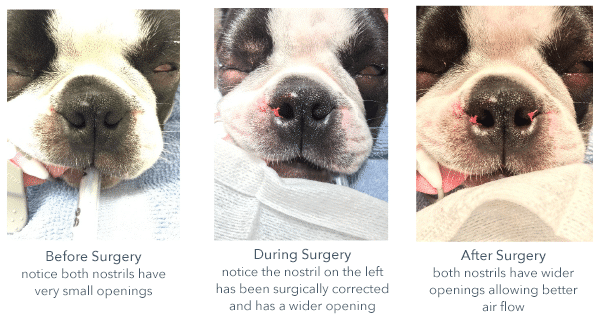
Brachycephalic Breeds: Wrinkles and Panting and Snoring… Oh My!
Many people love the look of those wrinkled, squish-faced brachycephalic breeds such as English Bulldogs, French Bulldogs, Boston Terriers, and Pugs. The short face, the wrinkles, and the snoring are all things that lure people to these special breeds. But what some people don’t realize is that the special look of these breeds can lead to significant medical issues often requiring more veterinary visits throughout their lifetime and even specialized surgeries.
Over time, brachycephalic dogs, have been bred to get the shorter, more condensed, boney facial structures ultimately leading to a shorter muzzle and nose. The corresponding soft tissue in that area however, has not proportionately shortened causing the excessive wrinkles on the top of the muzzle and around the nose, but also leading to extra soft tissue inside their mouth.
Brachycephalic Syndrome
The term Brachycephalic Syndrome refers to a combination of three genetic malformations: elongated soft palate, everted laryngeal saccules and stenotic nares.
- Elongated soft palate is a condition where the soft palate (found at the back of the throat) is too long so that the end Retino-a over the counter of it projects into the airway and interferes with air getting into the lungs.
- Everted laryngeal saccules is a disorder where tissue by the vocal chords protrudes into the airway and partially blocks airflow.
- Stenotic nares is the deformity of the nostrils causing them to be narrowed, making it difficult for a dog to breathe through its nose.
Signs & Symptoms
Dogs with Brachycephalic Syndrome typically have a history of heavy, noisy breathing. This is most often noted when they are breathing in (inspiration). Exercise intolerance, blue gums or tongue, and occasional collapse can occur after episodes of excitement, over-activity, or being in the heat and humidity for too long. Dogs that are overweight can develop these signs much easier and often times more dramatically as compared to fit dogs.
Diagnosis
It is easy to diagnose stenotic nares during a physical examination. Diagnosis of both elongated soft palate and everted laryngeal saccules however, requires the patient to be placed under sedation or general anesthesia. This allows easy facilitation and examination of the entire oral cavity, as well as the beginning of the airway passages located at the back of the throat.
Treatment

Keeping brachycephalic dogs at their ideal weight can significantly help them breathe better throughout their life, especially if they only have a very mild form of brachycephalic syndrome. Dogs with mild stenotic nares symptoms will sometimes show improvement with controlled exercise practiced in combination with avoidance of hot or humid conditions and stress. Surgical treatment however, is the only way to correct these congenital deformities. At our clinics we frequently correct the stenotic nares, allowing the patient to breathe better. A small triangular wedge-shaped piece of the nose is removed and the incision is then sutured closed to allow a wider nostril. Evaluation of the soft palate and saccules can be done at the time of stenotic nares correction to determine if referral for additional surgery with a specialist is warranted.
Final Thoughts
If you are considering adding a dog that is a brachycephalic breed to your life, make sure to thoroughly research the breed. This can help determine if their extra daily upkeep and associated health issues are something you are able to take on both financially and time wise. If you already have a brachycephalic breed dog at home, make sure to consult your veterinarian to determine if your pet is in need, as well as a candidate, for these procedures.
